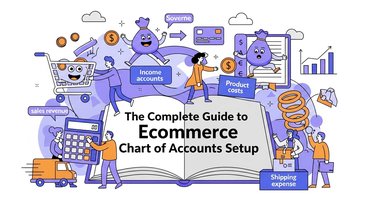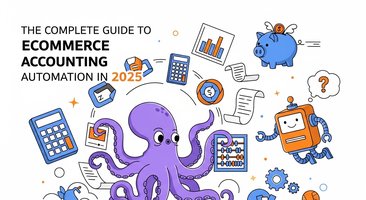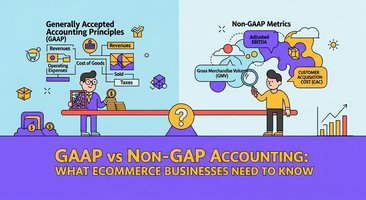Running an ecommerce business without understanding your financial statements is like flying a plane without instruments. You might stay airborne for a while, but eventually, you'll lose your way and potentially crash.
Financial statements are the dashboard of your ecommerce business, providing real-time insights into your financial health, operational efficiency, and growth trajectory. Unlike traditional retail businesses, ecommerce companies face unique challenges in financial reporting, from multi-channel sales tracking to complex inventory management across various fulfillment centers.
This comprehensive guide will transform the way you understand and utilize financial statements for your ecommerce business, helping you make informed decisions that drive sustainable growth and profitability.
Why Ecommerce Financial Statements Are Different
The Complexity of Modern Ecommerce
Traditional retail accounting focuses on single-location sales with straightforward inventory management. Ecommerce businesses, however, operate in a fundamentally different environment that creates unique financial reporting challenges.
Multi-Channel Revenue Streams
Modern ecommerce businesses sell across numerous platforms simultaneously. Your revenue might come from your Shopify store, Amazon marketplace, eBay listings, Etsy shop, and various other channels. Each platform has different fee structures, payout schedules, and reporting formats, making consolidated financial reporting significantly more complex.
Complex Payment Processing
Unlike traditional retail where customers pay directly at the point of sale, ecommerce transactions involve multiple intermediaries. Payment processors like Stripe, PayPal, and platform-specific systems deduct fees and may hold funds before releasing payouts. This creates timing differences between when sales are made and when cash is received.
Inventory Across Multiple Locations
Ecommerce inventory might be stored in your own warehouse, third-party fulfillment centers like Amazon FBA, dropshipping suppliers, or a combination of all three. This distributed inventory model requires sophisticated tracking to maintain accurate financial records.
Higher Return and Refund Rates
Online businesses typically experience return rates of 20-30%, significantly higher than traditional retail. These returns affect revenue recognition, inventory valuation, and cash flow in ways that traditional accounting methods weren't designed to handle.
The Stakes of Poor Financial Reporting
Inaccurate financial statements in ecommerce can lead to serious consequences including tax penalties, poor business decisions, investor mistrust, cash flow problems, and missed growth opportunities.
Without proper financial reporting, you're essentially running your business blindfolded, making decisions based on incomplete or inaccurate information.
The Three Essential Ecommerce Financial Statements
The Income Statement (Profit & Loss)
The Income Statement, also known as the Profit & Loss (P&L) statement, is your business's performance report card. It shows how much money you made, how much you spent, and what's left over as profit during a specific period.
Key Components for Ecommerce Businesses
Revenue
This includes all sales from your various channels, but it's crucial to track revenue by source. Your total revenue should encompass direct website sales, marketplace sales (Amazon, eBay, etc.), wholesale orders, subscription revenue, and any other income streams.
Cost of Goods Sold (COGS)
COGS includes the direct costs of producing or acquiring the products you sell. For ecommerce businesses, this typically includes product costs, shipping costs to your warehouse, import duties and tariffs, packaging materials, and fulfillment center fees.
Gross Profit
This is your revenue minus COGS, representing the profit before operating expenses. Gross profit margin is a critical metric for ecommerce businesses, as it indicates how efficiently you're sourcing and selling products.
Operating Expenses
These are the costs of running your business, including marketing and advertising, software subscriptions, employee salaries, warehouse rent, professional services, and payment processing fees.
Net Income
Your bottom line after all expenses, taxes, and interest payments. This is what's left to reinvest in the business or distribute to owners.
Reading Your Ecommerce P&L Statement
Performance Over Time Analysis
Compare your P&L statements month-over-month and year-over-year to identify trends. Look for seasonal patterns, growth trajectories, and any concerning changes in key metrics.
For example, if you notice that your gross profit margin is declining, investigate whether it's due to increased product costs, higher shipping expenses, or pricing pressure from competitors.
Percentage of Revenue Analysis
Express each line item as a percentage of total revenue to understand your cost structure. Industry benchmarks can help you determine if your expenses are in line with similar businesses.For most ecommerce businesses, COGS should typically be 40-60% of revenue, while marketing expenses often range from 10-30% depending on the growth stage and industry.
The Balance Sheet
Your balance sheet provides a snapshot of your business's financial position at a specific moment in time. It shows what you own (assets), what you owe (liabilities), and your ownership stake (equity).
Assets in Ecommerce
Current Assets
These are assets that can be converted to cash within one year, including cash and cash equivalents, accounts receivable, inventory (your most significant asset for most ecommerce businesses), and prepaid expenses.
Non-Current AssetsLong-term assets include property and equipment, intangible assets (trademarks, patents), and long-term investments.
Liabilities in Ecommerce
Current Liabilities
Obligations due within one year, including accounts payable, accrued expenses, short-term debt, and customer deposits or deferred revenue.
Non-Current Liabilities
Long-term obligations including long-term debt, lease obligations, and deferred tax liabilities.
Equity
The owner's stake in the business, including initial investment, retained earnings, and additional contributions.
Analyzing Your Ecommerce Balance Sheet
Liquidity Analysis
The current ratio (current assets divided by current liabilities) indicates whether you can meet short-term obligations. A ratio above 1.0 is generally good, but too high might indicate inefficient use of cash.
Inventory Management
Monitor your inventory levels closely. Too much inventory ties up cash and increases storage costs, while too little risks stockouts and lost sales.
Working Capital
This is current assets minus current liabilities, representing the cash available for day-to-day operations. Positive working capital is essential for smooth operations.
The Cash Flow Statement
The cash flow statement tracks the actual movement of cash in and out of your business, categorized into three activities: operating, investing, and financing.
Operating Activities
Cash generated from your core business operations, including cash received from customers, cash paid to suppliers, and cash paid for operating expenses.
Investing Activities
Cash used for investments in the business, such as equipment purchases, technology investments, and acquisitions.
Financing Activities
Cash from external financing sources, including loans, investor contributions, and dividend payments.
Understanding Ecommerce Cash Flow Patterns
Seasonal Variations
Many ecommerce businesses experience significant seasonal fluctuations. Understanding these patterns helps with cash flow planning and inventory management.
Payment Processing Delays
Unlike traditional retail, ecommerce businesses often experience delays between sales and cash receipt due to payment processing schedules. This timing difference must be accounted for in cash flow planning.
Inventory Investment Cycles
Cash flow is significantly impacted by inventory purchasing cycles, especially when preparing for peak seasons or launching new products.
Key Ecommerce Financial Metrics and KPIs
Revenue Metrics
Average Order Value (AOV)
Calculate total revenue divided by the number of orders. Increasing AOV through upselling, cross-selling, or bundling can significantly impact profitability.
Monthly Recurring Revenue (MRR)
For subscription-based ecommerce businesses, MRR provides predictable revenue insights and growth tracking.
Revenue Per Visitor
This metric helps evaluate the effectiveness of your website in converting traffic to sales.
Profitability Metrics
Gross Profit Margin
Essential for understanding the profitability of your products before operating expenses. Monitor this closely by product category and sales channel.
Net Profit Margin
Your overall profitability after all expenses. This is the ultimate measure of business efficiency.
Contribution Margin by Channel
Understand which sales channels are most profitable after accounting for channel-specific costs and fees.
Operational Efficiency Metrics
Inventory Turnover
How quickly you sell through inventory, calculated as COGS divided by average inventory value. Higher turnover generally indicates better efficiency.
Days Sales Outstanding (DSO)
For B2B ecommerce businesses, this measures how quickly you collect receivables.
Customer Acquisition Cost (CAC)
The cost to acquire a new customer, including all marketing and sales expenses.
Customer Lifetime Value (CLV)
The total revenue expected from a customer over their relationship with your business.
Ecommerce-Specific Financial Challenges
Multi-Channel Complexity
Revenue Recognition Across Platforms
Different sales channels may have varying revenue recognition requirements. Amazon sales might be recognized differently than direct website sales due to fee structures and return policies.
Fee Management
Each platform charges different fees that must be properly categorized in your financial statements. These might include listing fees, transaction fees, payment processing fees, and fulfillment fees.
Inventory Valuation Challenges
FIFO vs LIFO Methods
Choose the inventory valuation method that best reflects your business reality and provides tax advantages.
Obsolete Inventory
Ecommerce businesses must regularly assess inventory for obsolescence and write down unsellable items.
Inventory in Transit
Track inventory that's been ordered but not yet received, as well as inventory in fulfillment centers.
Tax Compliance Complexity
Sales Tax Across Jurisdictions
Ecommerce businesses must navigate complex sales tax requirements across multiple states and countries.
International Tax Implications
Cross-border sales create additional tax obligations and reporting requirements.
Returns and Refunds Management
Return Reserves
Estimate and set aside reserves for expected returns based on historical data.
Restocking and Processing Costs
Account for the costs associated with processing returns and restocking inventory.
How Financial Statements Connect
Understanding how your three financial statements interconnect is crucial for comprehensive financial analysis.
Income Statement to Cash Flow
Net income from your P&L is the starting point for your cash flow statement, but timing differences create variations between profit and cash flow.
Balance Sheet Changes
Changes in balance sheet items affect cash flow. For example, an increase in inventory requires cash investment, while an increase in accounts payable provides temporary cash relief.
Working Capital Impact
Changes in working capital components (inventory, receivables, payables) directly impact cash flow and must be managed carefully.
Technology Solutions for Ecommerce Financial Reporting
The Power of Automated Financial Reporting
Modern ecommerce businesses require sophisticated financial reporting tools that can handle the complexity of multi-channel operations, real-time data integration, and automated reconciliation.Manual financial reporting is not only time-consuming but also prone to errors that can lead to poor business decisions and compliance issues.
How Klavena Revolutionizes Ecommerce Financial Reporting
Klavena's comprehensive financial reporting platform addresses the unique challenges faced by ecommerce businesses through advanced automation and intelligent analytics.
Multi-Channel Financial Consolidation
Klavena automatically consolidates financial data from all your sales channels, payment processors, and fulfillment centers into unified financial statements. This eliminates the manual effort required to reconcile data from disparate sources and ensures accuracy across all reporting.
Real-Time Financial Dashboards
Access live financial data through intuitive dashboards that provide instant insights into your business performance. Monitor key metrics like revenue, profitability, and cash flow in real-time, enabling quick decision-making when opportunities or challenges arise.
Automated Revenue Recognition
Klavena handles complex revenue recognition scenarios automatically, including marketplace sales with varying fee structures, subscription revenue, and returns processing. This ensures compliance with accounting standards while providing accurate financial reporting.
Intelligent Expense Categorization
The platform automatically categorizes expenses from multiple sources, including payment processors, advertising platforms, and suppliers. This automation ensures consistent categorization and reduces the time spent on manual bookkeeping tasks.
Advanced Analytics and Reporting
Generate sophisticated financial reports that go beyond basic statements, including profitability analysis by channel, product performance metrics, customer lifetime value calculations, and predictive cash flow forecasting.
Compliance and Audit Trail
Maintain complete audit trails for all financial transactions with automated documentation that supports compliance requirements and simplifies year-end audits.
Customizable Financial Reports
Create custom reports tailored to your specific business needs, whether you're analyzing seasonal trends, evaluating marketing ROI, or preparing investor presentations.
Best Practices for Ecommerce Financial Management
Regular Financial Review Schedule
Monthly Financial Close
Establish a consistent monthly close process to ensure timely and accurate financial reporting. This should include reconciling all accounts, reviewing key metrics, and analyzing variances from budget or forecast.
Quarterly Business Reviews
Conduct comprehensive quarterly reviews that include trend analysis, competitive positioning, and strategic planning based on financial performance.
Annual Strategic Planning
Use annual financial reviews to set budgets, establish growth targets, and make strategic decisions about investments and expansion.
Key Performance Indicators (KPIs) Monitoring
Daily Metrics
Monitor critical daily metrics including revenue, conversion rates, and cash position to identify issues quickly.
Weekly Analysis
Review weekly trends in customer acquisition, inventory turnover, and operational efficiency.
Monthly Deep Dives
Conduct monthly analysis of profitability, channel performance, and financial health indicators.
Financial Controls and Processes
Segregation of Duties
Implement proper controls to prevent fraud and errors, including separating authorization, recording, and custody functions.
Regular Reconciliations
Reconcile all accounts monthly, including bank accounts, payment processors, and inventory systems.
Budget vs Actual Analysis
Compare actual results to budgets and forecasts to identify variances and their causes.
Common Mistakes in Ecommerce Financial Reporting
Revenue Recognition Errors
Timing Issues
Recognizing revenue before it's earned or failing to account for returns and refunds properly.
Channel-Specific Recognition
Not accounting for different revenue recognition requirements across various sales channels.
Inventory Management Mistakes
Inaccurate Valuation
Failing to properly value inventory or account for obsolete stock.
COGS Calculation Errors
Not including all costs in COGS calculations or misallocating costs between periods.
Cash Flow Mismanagement
Ignoring Timing Differences
Not accounting for delays between sales and cash receipt in cash flow planning.
Seasonal Planning Failures
Failing to plan for seasonal cash flow variations and inventory investment cycles.
Using Financial Statements for Strategic Decisions
Growth Planning
Investment Decisions
Use financial statements to evaluate potential investments in inventory, marketing, or technology.
Expansion Analysis
Analyze financial performance by channel or product category to guide expansion decisions.
Operational Optimization
Cost Management
Identify areas where costs can be reduced without impacting customer experience or growth.
Pricing Strategies
Use profitability analysis to optimize pricing across different channels and products.
Funding and Investment
Investor Presentations
Prepare compelling financial presentations that demonstrate business health and growth potential.
Loan Applications
Provide accurate financial statements to support loan applications and negotiate favorable terms.
Future Trends in Ecommerce Financial Reporting
Artificial Intelligence and Automation
Predictive Analytics
AI-powered tools will increasingly provide predictive insights based on financial data, helping businesses anticipate trends and make proactive decisions.
Automated Anomaly Detection
Machine learning algorithms will automatically identify unusual patterns or potential issues in financial data.
Real-Time Reporting
Instant Financial Insights
Technology will continue to enable more real-time financial reporting, allowing businesses to make faster decisions based on current data.
Integrated Business Intelligence
Financial reporting will become increasingly integrated with other business intelligence tools to provide comprehensive business insights.
Enhanced Compliance Automation
Regulatory Updates
Automated systems will keep pace with changing regulations and ensure continuous compliance across jurisdictions.
Audit Automation
Technology will streamline audit processes and provide better documentation and transparency.
Conclusion: Mastering Ecommerce Financial Statements
Understanding and effectively utilizing financial statements is not just about compliance—it's about gaining the insights needed to build a successful, sustainable ecommerce business. The complexity of modern ecommerce operations requires sophisticated financial reporting that goes far beyond traditional accounting methods.
Key success factors include implementing automated financial reporting systems that can handle multi-channel complexity, establishing regular financial review processes to monitor performance and identify trends, utilizing advanced analytics to gain deeper insights into business performance, maintaining accurate inventory and revenue recognition practices, and leveraging financial data for strategic decision-making.
Klavena's comprehensive financial reporting platform eliminates the complexity of ecommerce financial management while providing the insights needed for strategic growth. By automating the technical aspects of financial reporting, business owners can focus on what they do best—growing their business and serving customers.
The investment in proper financial reporting systems and processes pays dividends through improved decision-making, better cash flow management, enhanced investor confidence, streamlined operations, and sustainable growth.
As ecommerce continues to evolve, businesses that master financial reporting will have a significant competitive advantage in managing profitability, scaling operations, and achieving long-term success.
Ready to transform your ecommerce financial reporting? Discover how Klavena's advanced reporting capabilities can provide the insights and automation needed to take your business to the next level.





